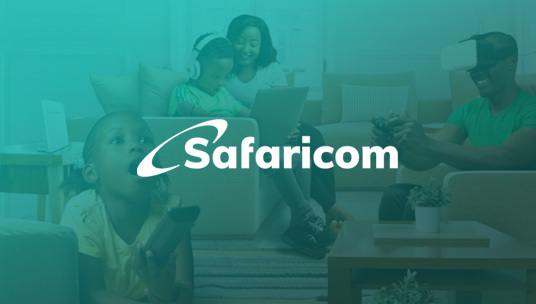
Introduction
In Kenya, the struggle for reliable internet connectivity in semi-urban and rural areas has been a significant challenge, leaving many communities with limited opportunities to participate in the digital world. The lack of proper internet access in these underserved regions has hindered their ability to bridge the digital divide and fully embrace the advantages of modern technology. However, recent efforts have been made to address these issues and provide improved internet infrastructure to empower these communities with better access to the digital realm. In light of this, MediaPal partnered with Safaricom to bridge this gap and transform lives. MediaPal launched a Lead Generation Campaign, that sought to collect high-quality leads, and onboard Kenyans onto the new Safaricom’s 4G WiFi, a high-speed superior network that would empower Kenyans with newfound opportunities online.
CAMPAIGN OBJECTIVE
Our objective was to tackle the challenges of internet access in underserved areas by raising awareness and facilitating easy access to the digital world. MediaPal used its advertising technology to help Safaricom onboard new users by taking the application to the user and not wait for them to go to Safaricom. By doing so, the campaign aimed to empower communities with improved internet infrastructure, bridging the digital divide and unlocking numerous opportunities for growth and development. Through our efforts, we strove to inform and educate people about the importance of reliable internet connectivity, ensuring that those in remote and rural regions could easily access the internet and fully embrace the advantages of modern technology.
Target Audience
Our campaign targeted a diverse audience, encompassing both men and women aged 18 to 55 years, living in sub-urban and rural areas of Kenya. These people displayed keen interests in Business, Internet, Telecommunications, Computers, Electronics, Sports, Art, Entertainment, Real Estate, Gaming, Home & Garden. By tailoring our approach to this specific demographic, we were able to effectively connect with tech-savvy individuals who were interested in various aspects of online life, gaming, and streaming. Additionally, we sought to engage businesses, homeowners, renters, educational institutions and internet service providers (ISPs) who showed an affinity for technology and internet-related services. Our strategic targeting enabled us to reach a wide range of people with diverse interests and behaviors, contributing to the success of our campaign. By also specifically targeting these tech-savvy segments, MediaPal ensured that the campaign resonated with individuals who were more likely to embrace the advantages of advanced connectivity and the superior features offered by the Safaricom 4G Wi-Fi network.
CAMPAIGN AD EXECUTION
MediaPal collaborated with Safaricom and came up with a new innovative ad execution that would target users at the comfort of their homes and collect their data (first party data). This created accessibility and brought down barriers to the onboarding process by taking the application to the user and not wait for them to go to Safaricom. MediaPal provided a business development tool for Safaricom to onboard more users to their internet network and discover the areas where there was more demand. By doing so, the campaign aimed to empower communities with improved internet infrastructure, bridging the digital divide and unlocking numerous opportunities for growth and development. Through our efforts, we strove to inform and educate people about the importance of reliable internet connectivity, ensuring that those in remote and rural regions could easily access the internet and fully embrace the advantages of modern technology.
LEAD GENERATION AD CREATIVE
The conversational ads initiated vibrant conversations, resulting in a substantial number of The Safaricom 4G Wi-Fi campaign achieved remarkable success, surpassing initial expectations. The campaign’s success can be attributed to several key factors:
Increased Lead Generation: Over the course of the one-month campaign, Safaricom successfully collected 561 leads
Low Cost Per Lead: Lowest cost per lead achieved at $5.26
Significant Conversion Boost of 40%: Safaricom witnessed a substantial boost in conversions, with customers actively embracing the advantages of Safaricom’s 4G network.
Data-Driven Insights: The campaign provided Safaricom with valuable first-party data, enabling the development of a detailed understanding of the target audience’s preferences and behaviors for future campaigns
CAMPAIGN SUCCESS
The campaign garnered 561 leads, and through integration with their customer relationship management (CRM) systems, there was seamless transfer of the captured leads directly into their CRM. This streamlined the lead management process and enabled them to nurture and convert leads more effectively. There was also an increase in internet connectivity around rural and semi-urban communities. The campaign put Safaricom at the forefront of internet providers due to its customer-focused approach, creating hassle-free experiences.
CONCLUSION
The joint effort between MediaPal and Safaricom significantly contributed to digital inclusion and empowered marginalized communities to participate in the digital landscape.By providing reliable internet solutions, more users are being onboarded onto their platform leading to wider customer base and market share. Furthermore, the campaign opened doors to education by providing access to resources like e-learning platforms, empowering individuals with knowledge and skills. People were also able to engage in online businesses, access healthcare services remotely, and stay connected with loved ones. In the spirit of ‘Tuinuane’ (animate), which means let us lift each other, the campaign renewed a sense of inspiration and hope in making the future better for everyone by creating equal opportunities in the digital world.marginalized communities to participate in the global digital landscape, breaking down barriers and reducing the digital divide between rural and urban areas.